Decoding DTC P3021: Hybrid Battery Assembly Causes & Solutions

When the dreaded check engine light illuminates, it’s often accompanied by a cryptic set of alphanumeric characters, such as DTC P3021 in Toyota Hybrids. This code points to a potential issue with the hybrid battery assembly. But what exactly causes this fault, and how can it be rectified? Let’s explore the potential causes and remedies for DTC P3021. Fix this P3021 Understanding DTC P3021 DTC P3021 specifically relates to faults within the hybrid battery assembly of Toyota vehicles. When this code is triggered, it indicates an anomaly in the performance or health of the hybrid battery system. Exposing hybrid battery components to extreme temperatures, whether excessively hot or cold, can expedite their degradation, potentially resulting in faults. Possible Causes of DTC P3021 Hybrid Battery Degradation: Over time, hybrid batteries can degrade due to repeated charge-discharge cycles, leading to diminished capacity and performance. Cell Imbalance: Imbalance among individual cells within the hybrid battery pack can result in voltage irregularities, triggering DTC P3021. Temperature Extremes: Exposure to extreme temperatures, whether hot or cold, can hasten the deterioration of hybrid battery components, resulting in potential faults. Faulty Battery Management System (BMS): Issues with the BMS, responsible for monitoring and controlling the hybrid battery’s functions, can contribute to the triggering of DTC P3021. Electrical Faults: Any electrical faults within the hybrid battery system, such as damaged wiring or connectors, can lead to abnormal readings and trigger the code. How to Fix DTC P3021 Diagnostic Scan: Start by performing a comprehensive diagnostic scan using an OBD-II scanner to retrieve the precise trouble code and pinpoint the underlying cause of the problem. Inspect Battery Assembly: Visually inspect the hybrid battery assembly for any signs of physical damage, leakage, or corrosion. Ensure all connections are secure and undamaged. Battery Testing: Perform comprehensive testing of the hybrid battery cells to assess their health and identify any imbalance or degradation. This may involve specialized equipment and expertise. Address BMS Issues: If faults with the Battery Management System are detected, address them accordingly. This may involve recalibration, software updates, or component replacement. Repair or Replacement: Depending on the severity of the issue, either repair or replace the malfunctioning components within the hybrid battery assembly. This could range from individual cell replacement to a complete battery pack replacement. Clear DTC P3021: After addressing the underlying issue, clear the DTC P3021 trouble code using the OBD-II scanner to reset the vehicle’s engine control module (ECM) and extinguish the check engine light. Cost to Diagnose and Repair The cost to diagnose DTC P3021 can vary depending on several factors, including the extent of the issue, the need for specialized equipment or expertise, and whether repairs can be performed in-house or by a professional technician. Repair expenses can fluctuate considerably based on the seriousness of the problem, spanning from a few hundred dollars for minor fixes to several thousand dollars for battery substitution in extreme scenarios. Call know for the exact cost. DTC P3021 in Toyota Hybrids signals potential issues within the hybrid battery assembly, necessitating prompt diagnosis and repair to ensure optimal vehicle performance and reliability. By understanding the possible causes and following appropriate repair procedures, drivers can effectively address this fault and get back on the road with confidence.
Decoding DTC P3022: Hybrid Battery Assembly Faults Revealed
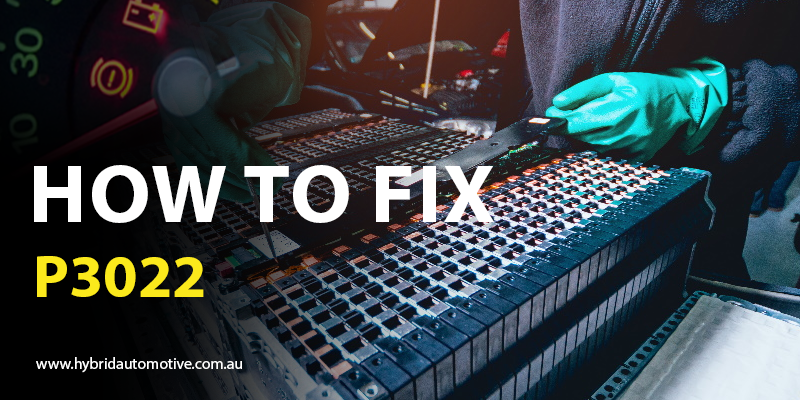
In the realm of automotive diagnostics, the occurrence of Diagnostic Trouble Code (DTC) P3022 raises concerns, particularly when it pertains to hybrid vehicles. This code specifically indicates faults within the hybrid battery assembly, necessitating immediate attention to ensure optimal vehicle performance and safety. Fix this P3022 Possible Causes of the DTC P3022 Diagnostic Trouble Code (DTC) P3022 signals that something is amiss with the hybrid battery assembly in a vehicle. Understanding the potential reasons behind this code is crucial for effective troubleshooting and repair. Here are some common suspects: Hybrid Battery Degradation: Over time, the hybrid battery may degrade due to normal wear and tear. This degradation can manifest as reduced performance and trigger the appearance of DTC P3022. Cell Imbalance: Within the hybrid battery pack, individual cells may develop imbalances. These imbalances can lead to voltage irregularities that trigger the DTC. Faulty Battery Modules: Defective modules within the hybrid battery assembly can disrupt its overall functionality, leading to the generation of error codes like P3022. Temperature Extremes: Exposure to extreme temperatures, whether extremely hot or cold, can expedite battery deterioration. This degradation can contribute to the emergence of DTC P3022. Poor Maintenance: Ignoring regular maintenance of the hybrid battery system can worsen underlying problems. Routine checks, including inspections of the cooling system and software updates, are essential for optimal performance. How to Fix the DTC P3022 Diagnostic Scan: Begin by performing a comprehensive diagnostic scan using a professional OBD-II scanner to pinpoint the exact cause of the error code. Battery Health Check: Conduct a thorough inspection of the hybrid battery assembly, assessing each cell’s voltage and overall health to identify any potential imbalances or defects. Module Replacement: If faulty modules are detected, replace them promptly with genuine OEM parts to restore the integrity of the hybrid battery pack. Temperature Management: Implement measures to regulate the temperature of the hybrid battery system, such as installing thermal insulation or utilizing active cooling systems. Software Upgrades: Ensure that the vehicle’s software is up-to-date, as manufacturers often release patches and upgrades to address known issues related to hybrid battery performance. Routine Maintenance: Establish a regular maintenance schedule for the hybrid vehicle, including periodic checks of the battery system and adherence to manufacturer recommendations. Cost to Diagnose the Code The cost of diagnosing DTC P3022 can vary depending on several factors, including the vehicle make and model, the severity of the issue, and the labor rates charged by the service provider. On average, anticipate spending anywhere from $100 to $300 for a professional diagnostic scan and initial evaluation. However, the total cost of repairs may increase significantly if extensive repairs or component replacements are required to rectify the underlying issue. Addressing DTC P3022 requires a systematic approach, starting with a thorough diagnostic scan to identify the root cause of the problem. By understanding the potential causes and implementing appropriate solutions, hybrid vehicle owners can effectively mitigate the risks associated with faulty hybrid battery assemblies, ensuring continued performance and reliability on the road.
Maximizing Cold Weather Performance of Hybrid Car Batteries

Hybrid cars have become popular lately because they save fuel and are good for the environment. The most important part of these cars is their batteries, which power the electric motors and store energy. However, one challenge faced by hybrid car owners, particularly in colder climates, is maximizing the performance of their batteries in cold weather conditions. Understanding Cold Weather Impact Cold weather can have a detrimental effect on the performance of hybrid car batteries. When it gets cold, the chemical reactions in the battery slow down, making it less efficient at delivering power. This phenomenon, often referred to as “cold weather degradation,” can lead to decreased range and overall performance of the vehicle. Factors Affecting Cold Weather Performance Several factors contribute to the diminished performance of hybrid car batteries in cold weather. Impact of Temperature on Performance Temperature plays a fundamental role in battery performance. Cold temperatures can cause batteries to lose capacity and efficiency due to slower chemical reactions. Conversely, high temperatures can lead to overheating and accelerated degradation. Understanding the differences in performance between cold and hot weather conditions is essential for implementing effective management strategies. Chemical Reactions in Cold Conditions Batteries work by using chemical reactions to make electricity. When it’s cold, these reactions happen slower, so the battery can’t give power as well. This happens a lot with lithium-ion batteries, like the ones in phones and electric cars. Cold weather makes the battery harder to use, causing it to lose power and work less effectively. Battery Capacity and Efficiency Cold weather can also affect the overall capacity and efficiency of batteries. When it gets colder, the battery doesn’t hold as much power. This means that a battery that can provide a certain amount of energy at room temperature may deliver less energy in cold weather conditions. Additionally, the efficiency of the battery may be reduced, leading to increased energy losses and decreased overall performance. External Factors In addition to temperature, several other external factors can influence cold weather performance. Humidity levels, wind chill, and elevation can all impact the behavior of batteries in cold weather conditions. It’s important to know and consider these things so we can predict how well the battery will work and come up with good plans to manage it. Technological Solutions To address the challenges of cold weather performance, various technological solutions have been developed. We can use heaters to keep the battery at the right temperature, so it works well even when it’s cold outside. Additionally, insulation and thermal management systems can help to minimize heat loss and maintain stable operating temperatures. Maintenance Practices Taking care of the battery regularly is important to make sure it works well in cold weather and lasts a long time. This includes ensuring proper insulation, checking for any signs of damage or degradation, and keeping the battery charged and maintained at optimal levels. Doing these things can make sure the cold doesn’t make the battery work badly and keep it working well. Case Studies and Examples Looking at real examples helps us understand the problems and fixes for batteries not working well in the cold. Success stories from industries such as automotive, aerospace, and renewable energy highlight the importance of addressing factors affecting cold weather performance and the benefits of implementing effective management strategies. Future Trends Looking ahead, advancements in battery technology and cold weather performance management are expected to continue. Innovations such as improved materials, advanced thermal management systems, and predictive analytics hold the potential to further enhance cold-weather performance and reliability. Researching and improving is important to make batteries work their best in cold weather. Strategies for Maximizing Cold Weather Performance Cold temperatures can affect various systems, causing fluid thickening, reduced traction, and increased energy consumption. Understanding these challenges is crucial for developing effective strategies to overcome them. Engine Warm-up Techniques It’s important to let the engine warm up properly for it to work well in cold weather. Techniques such as using block heaters, idling for a few minutes before driving, and selecting the appropriate viscosity oil can help reduce friction and ensure smoother operation. Tire Maintenance and Traction Management Maintaining proper tire pressure and using winter tires with good traction is critical for safe driving in icy or snowy conditions. Regularly checking tire tread depth and rotating tires can also improve traction and stability on cold roads. Battery Optimization Cold weather can significantly impact battery performance, leading to decreased efficiency and capacity. Insulating the battery, using heating systems, and managing charging patterns can help maintain optimal operation and extend battery life. Fluid Management Proper maintenance of antifreeze, windshield washer fluid, and other fluids is essential for preventing freezing and ensuring smooth operation of vehicle systems in cold weather. Regular inspections and top-ups can help avoid disruptions and costly repairs. Equipment Preparation and Storage Equipment and machinery should be properly prepared and stored during cold weather to prevent damage and ensure reliable operation. This includes lubrication, insulation, and periodic maintenance to mitigate the effects of freezing temperatures. Environmental Considerations In addition to vehicle and equipment maintenance, it’s essential to consider environmental factors in cold weather. Protecting vegetation, wildlife, and outdoor structures from freezing temperatures can help minimize the impact of winter conditions.
Decoding P3016: Hybrid Battery Assembly Fault Explained
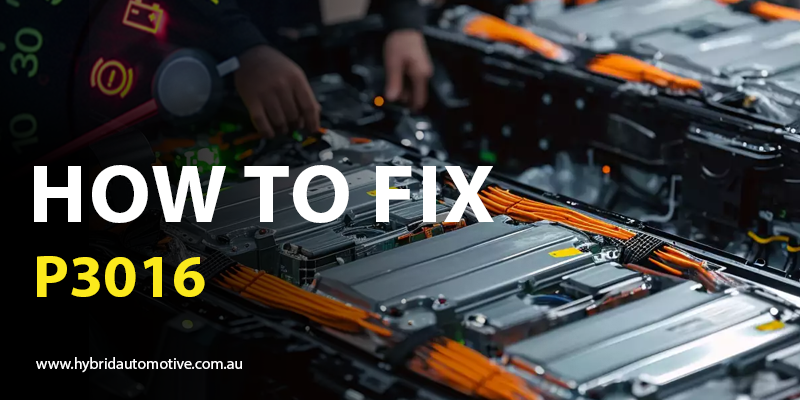
The P3016 code is a diagnostic trouble code (DTC) that indicates a potential issue with the hybrid battery assembly in your vehicle. This code can trigger the check engine light and lead to performance issues if left unaddressed. Grasping the potential causes and solutions for this code is crucial for preserving the well-being of your hybrid vehicle. Fix this P3016 The Possible Causes of the DTC P3016 Toyota? Battery Cell Degradation: Over time, the individual cells within the hybrid battery assembly can degrade, leading to reduced performance and triggering the P3016 code. Battery Module Failure: If one or more modules within the hybrid battery assembly fail, it can cause voltage irregularities and trigger the P3016 code. Temperature Extremes: Exposure to extreme temperatures, whether excessively hot or cold, can hasten the deterioration of the hybrid battery assembly, resulting in performance issues and activating the P3016 diagnostic trouble code. Poor Maintenance: Lack of proper maintenance, such as failing to regularly inspect and service the hybrid battery assembly, can lead to premature failure and trigger the P3016 code. How to Fix the DTC P3016 Toyota? Battery Replacement: In many cases, resolving the P3016 code requires replacing the entire hybrid battery assembly with a new or refurbished unit. This ensures optimal performance and reliability. Module Replacement: If the issue is isolated to specific modules within the hybrid battery assembly, replacing those modules individually can be a cost-effective solution to address the P3016 code. Temperature Management: Implementing measures to regulate the temperature of the hybrid battery assembly, such as installing thermal insulation or using a cooling system, can help mitigate the risk of triggering the P3016 code due to temperature extremes. Regular Maintenance: Performing routine inspections and maintenance on the hybrid battery assembly, including checking for signs of degradation and ensuring proper charging and discharging cycles, can help prevent issues that lead to the P3016 code. Cost to Diagnose The cost to diagnose and repair the P3016 code associated with a faulty hybrid battery assembly can vary depending on several factors, including the make and model of your vehicle, the extent of the issue, and labor costs. It’s crucial to seek advice from a certified technician or authorized dealership for a precise evaluation and cost estimation. The P3016 code related to a faulty hybrid battery assembly should not be ignored, as it can lead to further performance issues and potentially compromise the safety and reliability of your vehicle. Understanding the possible causes and solutions outlined above can help you effectively address this issue and ensure the continued operation of your hybrid vehicle.
Hybrid Battery Assembly P3015 Troubleshooting
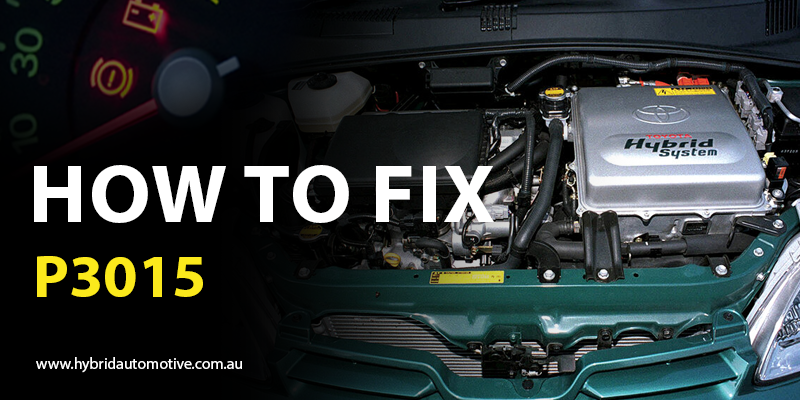
Hybrid vehicles provide an environmentally conscious alternative to conventional gasoline-powered cars, yet they present distinctive challenges of their own. One such challenge arises when a fault code P3015 appears, indicating potential issues with the hybrid battery assembly. Comprehending the potential causes and remedies can assist in effectively resolving this issue. Fix this P3015 Probable Causes Battery Degradation: Over time, hybrid batteries can degrade due to normal wear and tear, leading to reduced performance and triggering fault codes like P3015. Cell Imbalance: Imbalance among the individual cells within the hybrid battery assembly can cause voltage variations, resulting in error codes and diminished overall battery efficiency. Temperature Extremes: Exposing hybrid batteries to extreme temperatures, whether excessively hot or cold, can hasten their degradation and contribute to the occurrence of fault codes. Charging System Malfunction: Issues with the vehicle’s charging system, such as a faulty charger or charging control module, can impact the hybrid battery’s health and trigger error codes like P3015. Effective Solutions Battery Replacement: In cases of severe degradation or damage to the hybrid battery assembly, installing a new or refurbished unit may be necessary to address the P3015 fault code. Cell Balancing: Professional recalibration or cell balancing procedures can help restore balance among the individual cells within the hybrid battery assembly, improving overall performance and resolving error codes. Temperature Management: Implementing measures to regulate the temperature of the hybrid battery, such as installing thermal insulation or using climate control systems, can mitigate the impact of temperature extremes on battery health. Charging System Diagnosis and Repair: A thorough diagnosis of the vehicle’s charging system by a qualified technician can identify and address any underlying issues contributing to the P3015 fault code, such as malfunctioning chargers or control modules. Cost Considerations The cost of diagnosing a P3015 fault code related to a faulty hybrid battery assembly can vary depending on various factors, including the vehicle make and model, the extent of the issue, and the labor rates of the service provider. It is advisable to contact a professional automotive technician or dealership for an accurate cost estimate tailored to your specific situation. Addressing a P3015 fault code associated with a faulty hybrid battery assembly requires a thorough understanding of the potential causes and appropriate repair solutions. By taking proactive measures to maintain the health of your hybrid vehicle’s battery system and promptly addressing any emerging issues, you can ensure optimal performance and prolong the lifespan of your vehicle’s hybrid components.
Diagnosing P3014: Hybrid Battery Assembly Issues
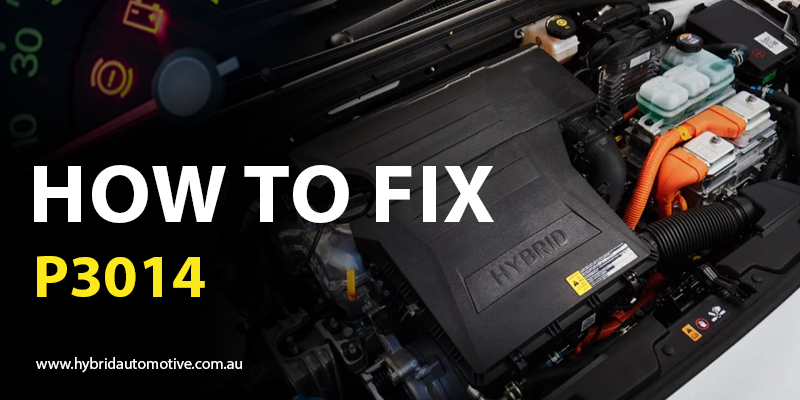
The emergence of the P3014 fault code in hybrid vehicles can signal a range of issues, but one common culprit is a malfunctioning hybrid battery assembly. This code, often accompanied by warning lights on the dashboard, requires prompt attention to ensure the vehicle’s optimal performance and longevity. Let’s examine the potential causes of this code and investigate solutions to address it effectively. Fix this P3014 Understanding the P3014 Code: Possible Causes Degraded Battery: Over time, the cells within the hybrid battery pack can degrade, leading to diminished performance and triggering fault codes like P3014. Battery Cooling System Malfunction: Inadequate cooling or malfunctioning of the battery’s cooling system can cause overheating, affecting battery performance and triggering fault codes. Faulty Battery Management System: Issues with the battery management system, responsible for monitoring and controlling the hybrid battery, can lead to erroneous fault codes like P3014. Physical Damage or Corrosion: Physical damage to the battery pack or corrosion on terminals can disrupt electrical connections, leading to fault codes and performance issues. Software Glitches: Sometimes, software glitches or bugs in the vehicle’s onboard computer systems can erroneously trigger fault codes like P3014. Resolving the P3014 Code: How to Fix Diagnostic Scan: Begin by conducting a diagnostic scan using specialized diagnostic tools to pinpoint the exact cause of the fault code. Battery Inspection: Examine the hybrid battery assembly for any physical damage, corrosion, or leaks. Attend to any identified issues promptly during the examination. Testing Battery Cells: Perform a comprehensive test on individual battery cells to identify any degraded or malfunctioning cells that might be causing the fault code. Check Cooling System: Ensure that the battery cooling system is functioning correctly. Clean or repair cooling components as necessary to prevent overheating issues. Update Software: If a software glitch triggers the fault code, updating the vehicle’s software to the latest version may resolve the issue. Replace Faulty Components: If any components within the hybrid battery assembly or the battery management system are found to be faulty, replace them with genuine parts recommended by the manufacturer. Professional Assistance: Seek the expertise of qualified technicians or specialists experienced in hybrid vehicle repair if you’re unsure about diagnosing or fixing the issue yourself. Cost to Diagnose The expense associated with diagnosing and repairing the P3014 fault code may fluctuate based on factors such as the severity of the issue, the make and model of the vehicle, and the labor rates charged by the repair facility. It is recommended to reach out to nearby automotive repair shops or dealerships to obtain precise pricing details. The P3014 fault code associated with faulty hybrid battery assembly requires thorough diagnostic procedures and targeted solutions. By understanding the potential causes and following appropriate repair steps, hybrid vehicle owners can ensure optimal performance and reliability.
P3013 Error Code: Troubleshooting and Resolution Guide
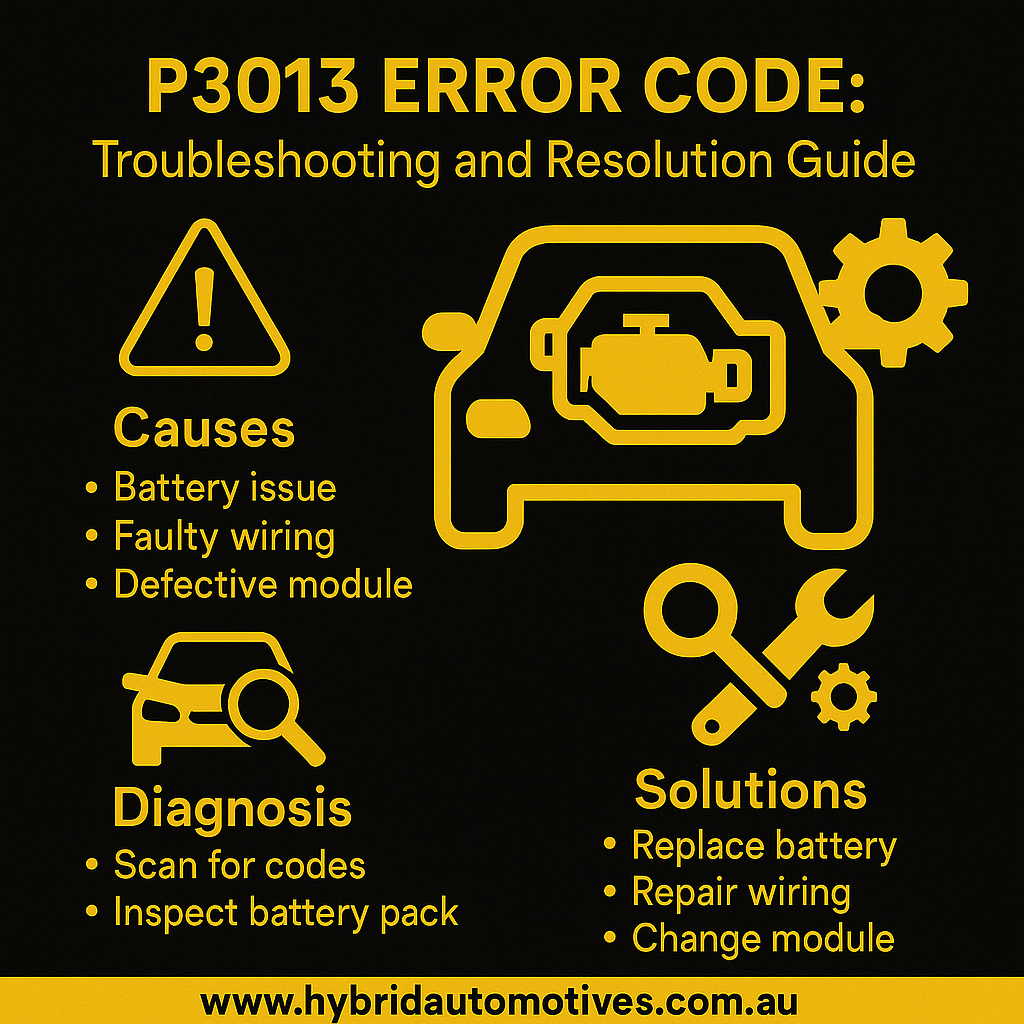
In hybrid vehicles, the P3013 fault code can be a concerning signal of trouble within the hybrid battery assembly. As a driver, encountering this code can trigger a cascade of questions regarding the root cause, potential fixes, and associated costs. We will delve into the possible causes of the P3013 code, methods to address it, and considerations regarding the cost of diagnosis and repair. Fix this P3013 Understanding the P3013 Code The P3013 code specifically pertains to hybrid vehicles and indicates an issue within the hybrid battery assembly. This code typically signifies a malfunction or irregularity in the performance of the battery, affecting the vehicle’s hybrid system’s efficiency and functionality. While the code itself provides a clear indication of trouble, diagnosing the precise cause requires a comprehensive assessment of various components and systems. Possible Causes of the P3013 Code Degraded Battery Cells: Over time, the individual cells within the hybrid battery can degrade due to age, usage patterns, and environmental conditions. Degradation can lead to diminished battery capacity and efficiency, triggering fault codes like P3013. Faulty Battery Management System (BMS): The BMS is responsible for monitoring and managing the hybrid battery’s performance and health. A malfunctioning BMS may misinterpret data or fail to regulate the battery’s operation effectively, resulting in fault codes such as P3013. Electrical Issues: Wiring faults, loose connections, or damaged electrical components within the hybrid system can disrupt the flow of power to and from the battery assembly, causing irregularities that trigger fault codes. Temperature Extremes: Exposure to extreme temperatures, whether excessively high or low, can expedite battery degradation and compromise its performance, potentially resulting in the appearance of fault codes such as P3013. How to Fix the P3013 Code Resolving the P3013 code requires a systematic approach to identify and address the underlying cause. Here are some common steps taken to rectify this issue: Diagnostic Assessment: A thorough diagnostic procedure, typically performed by trained technicians using specialized tools and software, is necessary to pinpoint the exact cause of the fault code. This assessment may involve testing the battery cells, inspecting the BMS, and examining the electrical system for anomalies. Battery Replacement or Repair: Depending on the severity of the problem and the extent of damage to the battery assembly, repair or replacement may be required. In some cases, individual faulty cells can be replaced, while in others, the entire battery pack may need to be swapped out. BMS Calibration or Replacement: If the fault lies with the battery management system, recalibration or replacement of the BMS may be required to ensure proper monitoring and control of the battery’s operation. Addressing Electrical Faults: Any identified electrical faults or wiring issues must be rectified to restore the integrity of the hybrid system and prevent future occurrences of fault codes. Cost to Diagnose and Repair The cost associated with diagnosing and repairing the P3013 code can vary significantly depending on factors such as the vehicle’s make and model, the extent of the issue, and the labor rates charged by the service provider. Diagnostic fees typically range from modest amounts to higher charges for more complex assessments involving advanced diagnostic equipment. Repair costs can encompass the expense of parts, labor, and any additional services required to resolve the issue comprehensively. Given the variability in costs, hybrid vehicle owners should obtain multiple quotes from reputable service centers and weigh their options carefully before proceeding with diagnosis and repair.
Troubleshooting Code P3012: Battery Block 1 Weakness

The P3012 fault code can be particularly troublesome for hybrid vehicle owners, as it frequently points to underlying issues within the hybrid battery assembly. We provide a comprehensive exploration of the potential causes that could trigger this code, offering practical solutions for resolving the issue and shedding light on the associated costs of diagnosis. Hybrid vehicles rely on a sophisticated interplay of traditional combustion engines and electric power systems, with the hybrid battery assembly is a critical component in this dynamic equation. When the vehicle’s onboard diagnostics detect a problem within this crucial system, it often manifests as the P3012 fault code, prompting owners to seek swift resolution. Fix this P3012 Understanding the Possible Causes Battery Cell Degradation: Over time, hybrid batteries can experience cell degradation, leading to reduced performance and triggering fault codes like P3012. Factors such as age, usage patterns, and environmental conditions can accelerate this degradation. Thermal Runaway: High temperatures can cause thermal runaway in hybrid batteries, leading to internal damage and triggering fault codes. This can occur due to overcharging, prolonged exposure to heat, or poor ventilation within the battery assembly. Voltage Imbalance: Voltage imbalances among battery cells can result from manufacturing defects, poor maintenance, or irregular charging patterns. Such imbalances can cause the battery management system to detect abnormalities and generate fault codes P3012. Internal Faults: Internal faults within the hybrid battery assembly, such as short circuits or damaged wiring, can trigger the P3012 code. These faults may arise due to manufacturing defects, physical damage, or wear and tear over time. Methods for Repair& Replacement Battery Replacement: In cases of severe degradation or internal faults, replacing the hybrid battery assembly may be necessary. This involves removing the old battery and installing a new one, ensuring compatibility with the vehicle’s specifications. Cell Balancing: If voltage imbalances are detected, cell balancing techniques can be employed to equalize the charge across battery cells. This may involve using specialized equipment or software to recalibrate the battery management system. Thermal Management: Implementing effective thermal management systems can help prevent thermal runaway and extend the lifespan of hybrid batteries. This may include improving cooling mechanisms, enhancing insulation, or installing temperature sensors to monitor battery temperatures. Diagnostic Testing: Thorough diagnostic testing is crucial to pinpoint the exact cause of the P3012 code. This may involve using diagnostic tools to analyze battery performance, check for voltage irregularities, and identify any internal faults. Associated Diagnostic Costs The cost of diagnosing a P3012 fault code can vary depending on several factors, including the make and model of the vehicle, the complexity of the issue, and the labor rates of the service provider. Since diagnostic fees are typically not standardized, it’s advisable to contact a certified mechanic or dealership for an accurate price estimate.
Improving Fuel Efficiency with Hybrid Car Batteries
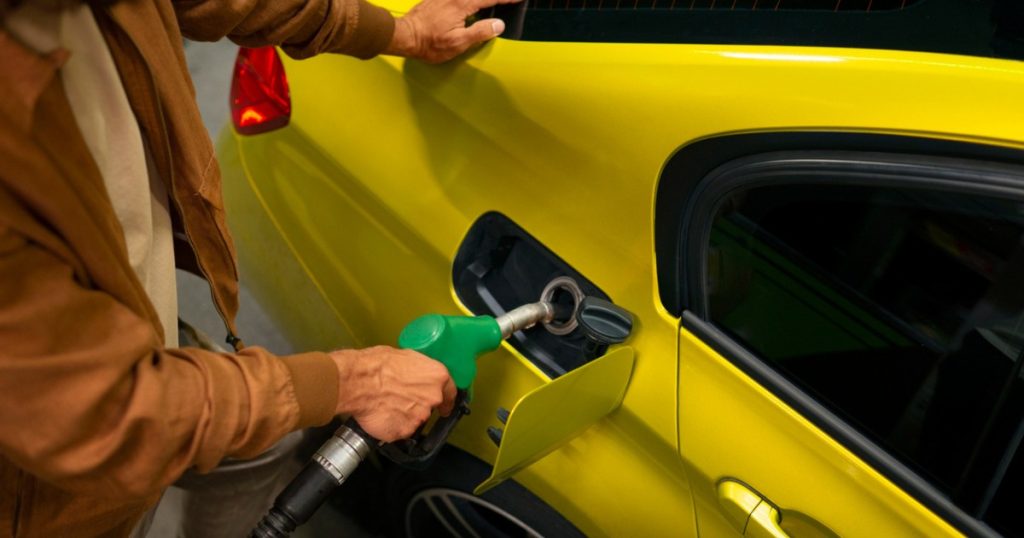
Hybrid vehicles have become a popular choice for eco-conscious drivers, offering significant fuel efficiency improvements compared to traditional gasoline-powered cars. The key to this efficiency lies within the hybrid battery. Explores how to optimize your hybrid battery’s performance to maximize your fuel economy and environmental impact. Understanding the Hybrid Battery’s Role: Hybrid batteries, typically lithium-ion, act as energy storage units. They capture energy from regenerative braking and power the electric motor for low-speed driving and engine restarts. The more efficiently the battery operates, the less reliance there is on the gasoline engine, leading to improved fuel economy. Optimizing Battery Performance for Efficiency: In a world reliant on technology, optimizing battery performance is key. Join us as we explore strategies for efficiency and longevity. Master Regenerative Braking: Regenerative braking saves energy when you slow down or stop, turning it into electricity for the battery. Anticipate traffic flow and practice smooth, controlled braking to maximize energy capture. Coasting to a stop whenever possible further increases efficiency. Driving Style Matters: Aggressive acceleration, frequent high-speed driving, and unnecessary use of the gasoline engine put a strain on the battery and decreased fuel efficiency. Aim for smooth, steady acceleration and maintain a moderate cruising speed. Embrace Eco Mode: Some hybrids have a mode called “Eco Mode” that saves gas. This mode may limit acceleration but optimizes electric motor usage, reducing reliance on the gasoline engine. Preconditioning (Optional): Some hybrids offer preconditioning features that use the gasoline engine to regulate battery temperature before driving. This helps in very hot or cold weather because a warm battery works better. However, use it judiciously to minimize gasoline consumption. Minimize Accessory Usage: Excessive use of climate control systems and power-hungry accessories like heated seats or phone chargers can drain the battery faster, forcing the gasoline engine to work harder. Utilize these features efficiently to maximize electric power usage. Maintaining Battery Health for Long-Term Efficiency: Maintaining battery health is vital for long-term efficiency. Highlights key practices to preserve battery lifespan and optimize performance. Let’s explore strategies for ensuring sustainable energy use. Parking Strategies: Extreme temperatures can negatively impact battery health. Park in shaded areas or garages whenever possible, especially during hot or cold weather. Charging Habits: While convenient, frequent fast charging can degrade battery health over time. Utilize standard charging whenever possible for optimal battery longevity and efficiency. Follow Manufacturer Recommendations: Hybrid battery systems may require specific maintenance or software updates. Check your car’s manual and do what it says to take care of the battery. Strategies for Optimizing Fuel Efficiency with Hybrid Car Batteries Hybrid car batteries help the car use less gas and pollute less. Here are some strategies to optimize fuel efficiency with hybrid car batteries: Utilize Electric Mode: Many hybrid vehicles offer an electric mode that allows them to operate solely on electric power for short distances. Utilize this mode during city driving or low-speed commutes to minimize fuel consumption and emissions. Maximize Regenerative Braking: Regenerative braking turn’s energy from braking into electricity for the battery. If you drive smoothly and know when to stop, you can save more energy and use the brakes less, which helps save gas. Monitor Battery Charge: Keep an eye on the battery charge level and aim to maintain it within the optimal range. Avoid letting the battery drain completely and recharge it regularly to ensure it’s ready to assist the internal combustion engine when needed, leading to improved fuel efficiency. Drive Efficiently: Try driving in ways that save gas, like slowly speeding up, keeping the same speed, and not stopping suddenly. These practices not only reduce fuel consumption but also help prolong the lifespan of the hybrid battery by minimizing strain on the engine and battery. Plan Routes Wisely: When possible, plan your driving routes to minimize unnecessary stops and maximize efficiency. Opt for routes with less traffic congestion and fewer stoplights to reduce the frequency of acceleration and braking, thereby conserving fuel and extending battery life. Maintain Proper Tire Pressure: Keeping your tires filled up with the right amount of air can help you use less gas. If your tires don’t have enough air, it’s harder for the car to move, so it uses more gas. Make sure to check your tires and fill them up to the right amount regularly to save gas. Avoid Excessive Idling: Idling consumes fuel unnecessarily and contributes to pollution. Don’t let your car sit and run for too long without moving—turn off the engine when you’re parked or waiting for a while. Hybrid vehicles can utilize their electric power for accessories such as air conditioning and entertainment systems without running the engine, further conserving fuel. Additional Tips: Tire Pressure: Make sure your tires have enough air in them like your car’s maker says. If they’re not full enough, it’s harder for the car to move, so it uses more gas. Route Planning: Plan your trips to minimize stop-and-go traffic. Hybrids excel at maintaining efficiency at consistent speeds. Anticipate Traffic: Smooth driving with fewer sudden stops allows for better utilization of regenerative braking and electric motor power. The Rewards of Optimization: By implementing these strategies, you can reap significant benefits: Increased Fuel Economy: A well-maintained and efficiently operated battery translates to a significant reduction in gasoline consumption, saving you money at the pump. Reduced Emissions: Using less gas means you make less pollution, which helps keep the air cleaner. Extended Battery Life: Proper care and driving habits can significantly extend the lifespan of your hybrid battery, reducing replacement costs and environmental impact.
Troubleshooting P3011: Hybrid Battery Assembly Fault
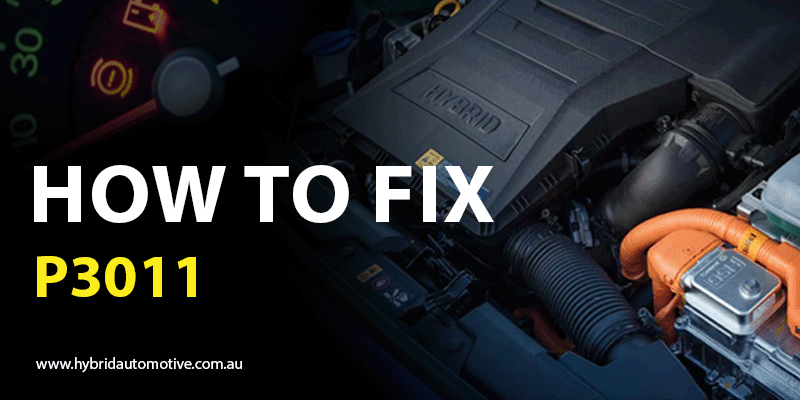
In hybrid vehicles, the P3011 code can be a cause for concern. This diagnostic trouble code (DTC) indicates a Fault in the Hybrid Battery Assembly, potentially disrupting the smooth functioning of the vehicle. Understanding the possible causes behind this issue and the steps to remedy it is essential for hybrid vehicle owners and technicians alike. Let’s delve into the depths of the P3011 code and explore its nuances. Fix this P3011 Possible Causes DTC P3011 Degradation of Battery Cells: Over time, the cells within the hybrid battery pack can degrade due to usage and environmental factors. This degradation can lead to a decrease in battery performance and trigger the P3011 code. Faulty Battery Management System (BMS): The BMS is responsible for monitoring and managing the hybrid battery pack. If there is a malfunction or error within the BMS, it may incorrectly interpret battery data, resulting in the P3011 code being generated. Internal Battery Module Issues: Individual modules can experience faults or failures within the hybrid battery pack. These issues may include internal shorts, cell imbalances, or physical damage, all of which can contribute to the triggering of the P3011 code. Temperature Sensing Problems: Hybrid battery performance is heavily influenced by temperature. If there are inaccuracies or malfunctions in the temperature sensors associated with the battery pack, it can lead to improper battery management and the generation of fault codes such as P3011. How to Fix the DTC P3011 Diagnostic Scan: The first step in addressing the P3011 code is to conduct a comprehensive diagnostic scan using specialized equipment. This scan will provide insight into the specific nature of the fault and help pinpoint the underlying cause. Battery Inspection: Once the fault has been identified, a thorough inspection of the hybrid battery assembly is necessary. This may involve testing individual battery cells, assessing the condition of the BMS, and checking for any physical damage or abnormalities within the battery pack. Repair or Replacement: Depending on the seriousness of the problem, repairs may be viable to correct the fault within the hybrid battery assembly. However, in cases of significant degradation or irreparable damage, replacing the entire battery pack may be the most viable solution. Calibration and Reset: Following any repairs or replacements, it’s crucial to calibrate the BMS and reset any fault codes stored within the vehicle’s system. This ensures that the hybrid vehicle operates optimally and prevents the recurrence of the P3011 code. Cost to Diagnose The expense of diagnosing and fixing a P3011 code can fluctuate considerably based on multiple factors, such as the hybrid vehicle’s make and model, the severity of the fault in the battery assembly, and the service provider’s labor rates. Due to the specialized nature of hybrid vehicle maintenance, it is recommended to consult with a qualified technician or dealership for an accurate cost estimate. Call for Cost.
